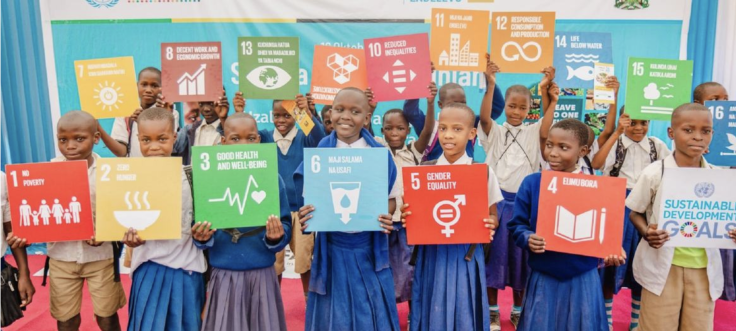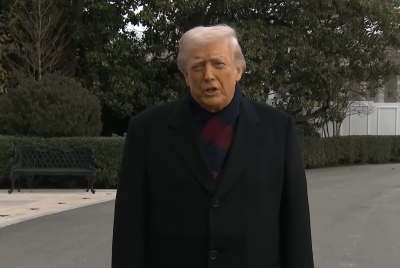Will innovative finance tackle the sustainable development goals and save the planet?
The world is halfway to the 2030 deadline of the UN Sustainable Development Goals. As challenges abound, a crucial issue needs attention: how to foot the bill.

There is a sense of urgency in the world of international development this year. The Annual Meeting of the UN General Assembly is slated for September.
That will mark the halfway point counting down towards the 2030 deadline set for the Sustainable Development Goals (SDGs) the United Nations unveiled in 2015.
Comprising 17 different themes, the SDGs spell out a comprehensive agenda to "bring peace and prosperity for people and the planet, now and into the future".
The Goals address a broad range of issues vital to continued global progress, including access to health and education, gender equity, inclusive economic opportunity and climate action.
At the same time, this year's United Nations Climate Change conference – COP28 – is much anticipated. The hope is that with the UAE as host, progress will be stepped up from last year and a wider range of participants, particularly private sector actors, will be persuaded to join.
Indeed, although COP conferences have been a regular fixture on the international development calendar since 1995, it is only in recent years that the general public has become more familiar with them.
The reason is obvious. With more and more dire climate predictions coming true, and climate disasters from forest fires in California to heatwaves in Europe, to flooding in Asia, are becoming commonplace, it is hard to deny the existential threat posed by climate change.
With the diversity of challenges implicit in the SDGs – only compounded by the recent developments of COVID-19 and the Ukraine War – one of the glaring issues is the funding gap the world faces.
To take one example, the estimated financing gap in the quest to be net zero by 2050 is £1.8 trillion ($2.3 trillion) a year.
The ascent of man and the ascent of money
In his book, The Ascent of Money, Harvard academic Niall Ferguson set out to demonstrate that underpinning all the major historical innovations familiar to the layperson – medical breakthroughs, technological innovations, lofty architecture and so on – there is some form of financial innovation.
Thus financial innovations are just as important, if less evident, as any of the rest. Ferguson explained: "The evolution of credit and debt was as important as any technological innovation in the rise of civilisation, from ancient Babylon to present-day Hong Kong."
Amongst the financial innovations that shaped the world as we know it today, Ferguson lists, for instance, the rise of the bond market in Renaissance Italy and the rise of limited liability corporations.
This is no less true today. And one of the questions being tackled in the world of international development is how to get the financing needed – in the daunting amounts required and at speed.
It is in this context that I spoke to Maria Kozsloski from the Rockefeller Foundation, about the Foundation's pioneering efforts in defining "Impact Investing" and setting up the structure necessary to operationalise the concept.
What is Impact Investing?
In October 2007, the Rockefeller Foundation brought together private investors at a series of convenings in New York City.
Here they finessed a new concept of development finance – one that relied not on charitable giving, but on profitable investments that would deliver positive social, environmental and economic impact to underserved and vulnerable communities.
In 2015, when the United Nations unveiled its Sustainable Development Goals (SDGs), The Rockefeller Foundation focused its impact-investing efforts on the areas delineated by the SDGs.
Specifically, the Rockefeller Foundation's Zero Gap program was born in 2019. It set out to create tailored financing solutions at scale to tackle the world's most pressing challenges as framed by the SDGs – from hunger to poverty to the preservation of ecosystems.
Its grant-making programme funds early-stage concept development for new financing mechanisms – the most underfunded phase in the lifecycle of a new investment product.
In other words, it provides the funding necessary for new ideas to see the light of day and translate into usable financial products.
The second stage is then for these products to funnel private capital towards profitable causes that make an impact - initiating with an investment by the Rockefeller Foundation itself, which helps unlock further private capital.
I spoke to Kozloski as the Zero Gap Fund's Report on 2022 is just about to be released.
As Kozloski puts it, these products fulfil a "pressing need for investment capital that is willing to come in early and bolster investment solutions that marry impact and return and have the potential to mobilise significant private capital".
The Zero Gap programme's grant portfolio has provided over £39 million ($50 million) in funding across 114 projects and £29 million ($38 million) to support the launch of 50 different financial products. This work evolved and eventually lead to the Zero Gap Fund in 2019, which is a $30 million investment fund in partnership with the MacArthur Foundation.
Déjà vu
Maria Kozloski arrived in Warsaw in the early 90's. It was the beginning of a new era, as the Iron Curtain fell and the country embraced freedom – but also grappled with the challenges of a new economic model.
Kozloski, an American, had recently finished a master's degree at Johns Hopkins. However, instead of returning to a career on Wall Street, she chose to indulge her curiosity about the world of development finance. Armed with a Wharton MBA and an MIT undergraduate education, she became one of the advisors who helped the liberalisation efforts of the Polish finance ministry under Leszek Balcerowicz.
"I went to Poland to help privatise State Owned Enterprises after the 'big bang' under Balcerowicz," she told me over the phone.
Fast forward 30 years and there is a new challenge in Eastern Europe – the War in Ukraine, of course. "New" is a relative term, though. As Putin has said himself, he is acting on a vision of a "Greater Russia" that recalls the old Soviet order.
And Kozloski is still at the forefront of development finance. I spoke to her in her capacity as Senior Vice President of the Innovative Finance team at the Rockefeller Foundation.
In 2022, the Innovative Finance team partnered with Horizon Capital, Ukraine's largest private equity firm, to help raise funds. Horizon Capital is Ukraine's leading private equity firm. It focuses on export-oriented, asset-light technology companies that are capable of surviving volatile market conditions.
The Ministry of Digital Transformation of Ukraine estimates that technology will represent 10 per cent of the economy by 2030.
Tech companies are playing a crucial role in not only propping up the economy during the war but in supporting the war effort itself. Among companies supported by Horizon are some that have kept crucial internet services running through the war.
Not only that but these companies play a role in stemming the brain drain from Ukraine and helping the economy function and survive through and past the war.
Innovative Finance
I want to understand more about promising financial products launched by the innovative finance team. Kozloski honed in on the team's Blue Forest project.
"Blue Forest is incredibly innovative. It is a bond product that tackles wildfire risk in the United States," Kozloski explained. "One of the big challenges in the United States – and globally – is that you have forest land that has not been tended to over long periods of time. Very thick forests suck up a lot of water; and when they are next to communities, that is highly destructive.
Getting to the crux of the financial approach, she said: "The US Forest Service is in principle willing to provide the funding to operationalise a healthy forest approach, to make them less dense; but you cannot get that money fast enough from the US forest service.
"So the Forest Resilience Bond (from Blue Forest) allows you to raise money upfront from private investors. The government will pay this back in time.
"Who buys it?" Kozloski asked, before answering herself: "Insurance companies; utility companies who are sitting next to forests."
She is obviously passionate about the subject, as she explained the potential scalability and replicability of the products or similar products.
Kozloski said: "Insurance companies, for instance, are very interested in climate-based products. They are facing climate disasters that they just cannot pay for. This shows that you can develop specific products to attract certain investment groups. Entities that have an interest in limiting climate change are willing to invest in these products."
She emphasised that insurance-based investment products to tackle climate change are a growing category of impact investing.
Spread too thin? What is the road to 2030?
Kozloski was in attendance at both COP26 and COP27. Hoping to get a flavour of what goes on behind closed doors, I asked her if there were any particular themes that were emphasised.
She mentioned that there is recognition of a need to direct funding towards traditionally under-resourced areas.
"Nature-based solutions and decarbonisation technology are getting some much-needed attention. The latter is not fully funded in the market. By contrast, a ton of funding is going to electronic vehicles," she said.
She mentioned other examples along the same theme, saying: "We also need to pay attention to agricultural supply chains and supply chain transformation. It's not just about moving to solar panels!
"Similarly, it's not just about CO2 emissions but also depleting nutrients in the soil with our intense agricultural practices."
There are a lot of issues, not enough resources. The work at the Rockefeller Foundation grapples with that same challenge.
"The benefit of the Zero Gap Fund is that we can do a lot of different things – giving us the flexibility to step in opportunistically when we want. On the flip side, there is a benefit to going deep into a theme."
Demonstrating the mood of the moment, Kozloski said: "In terms of diving deeper, we are doing that to a degree with climate change – partly because it's so urgent."
With the world midway to the 2023 SDG deadline, I ask her for her views on the prognosis at half-time.
"That's a really tough question," she responded.
She then continued: "To be honest, we have compounding challenges right now. I have worked in development for 30 years. There have been a lot of positives in that time, but come 2020, we had a lot of new challenges with covid. In recent years, there are more and more vivid signs of climate change. Emerging markets had a lot to grapple with – and the vulnerable communities within them, and indeed worldwide – had big setbacks."
She reckoned these recent speed bumps have made for a more challenging journey to 2030. However, she ended on a hopeful note, stating: "Despite all this, I will say, the current generation in Europe or the United States or in Africa where there are all these path-breaking tech entrepreneurs – that did not even exist ten years ago – you do see some incredible things happening.
"By our small contribution, we want to put wind in their sails – the ones out there at the forefront of innovation."
© Copyright IBTimes 2025. All rights reserved.






















